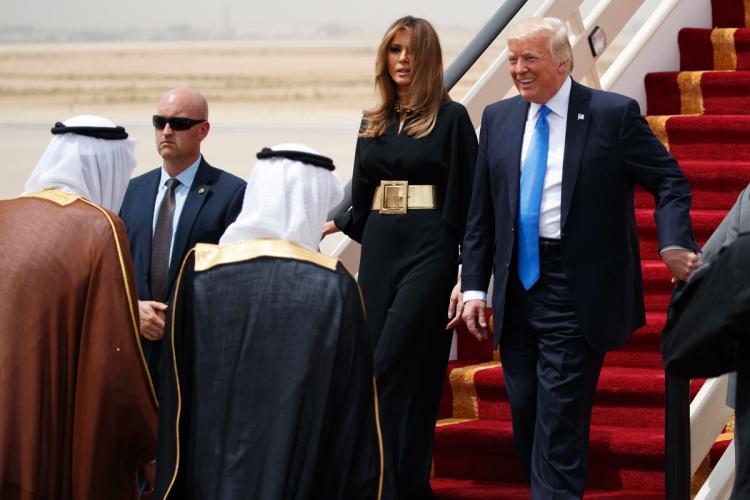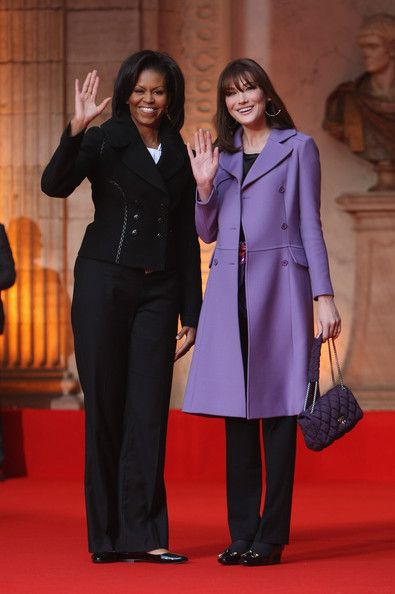
What is the Fashion Diplomacy?
The fashion industry has always been a reflect of the trade exchange and the diplomatic relations developed between States.
Since the 15th century, the diplomats and the important French storekeepers were encouraged to adapt their clothing style to the country where they went. Therefore, these travelers returned in Europe with suitcases full of traditional attires. Textiles and suits were a whole part of the royal presents that the powerful leaders exchanged during official visits.
Sovereignty needs to be represented and visualized. It requires the visualization of its ‘glory’ to sustain its ‘power’. ‘Recognition is a form of social visibility’ and ‘once we see social recognition as embedded in a visibility field’ new questions about political concepts become possible according to Andrea Brighenti.
Today, first ladies play a social role by using the fashion diplomacy. This strategic issue is taken seriously by the governments. For example, Brigitte Macron hired a stylist at her own expense. And most of the time, clothes are borrowed by the brands and returned immediately.
Politicians attach an importance to what they wear during diplomatic visits. They adhere to the unspoken rules. It’s part of the nonverbal communication.
In October 2016, the United States Chief of Protocol Peter A. Selfridge in partnership with ELLE Editor in Chief Robbie Myers hosted a conference “Diplomacy by Design” to highlight the role of fashion in diplomacy. Ambassadors and Senior Diplomats from over 180 countries were present. The goal was to explain how fashion transmit powerful diplomatic messages around the world. The Secretary of State John Kerry said that “fashion helps to create a national identity and can provide a platform on which countries can relate to each other.”
Why?
-
Sign of Respect
- The Queen Elizabeth always adapt her outfits in accordance with the local cultures of the country she visit. In 1970, during a visit to Australia she wore a dress and coat in the national color of Australia.
- Further, in 1961, she visited to the Vatican City and she met Pope John XXIII. To symbolize the solemnity of her visit, she was wearing a long dress in black lace and silk mantilla topped by a lace mantilla atop her head. The Queen showed her respect to the Vatican by following the dress code and wearing black in conventions.
- When the Duke and Duchess of Cambridge went to India for a week, she didn’t have any speeches scheduled. She used her wardrobe to convey her voice. It was an opportunity to send a diplomatic message of good will. Looking every inch the modern princess. By opting for a local designer, the Duchess used her outfits to pay respect to the host nation.
- In the same way, Melania Trump chose to honor her host nation by wearing Italian brand Dolce & Gabanna in her meeting with Pope Francis at the Vatican. She wore a black lace sheath dress with a matching veil. She chose to cover her head at the Vatican but not in Saudi Arabia.
-
Sign of Good Relationship between 2 Countries
- In Strasbourg, Michelle Obama and Carla Bruni-Sarkozy chose pants. Mrs. Obama was wearing Azzedine Alaia for the second day. Alaia is an expert tailor. By choosing this designer, Mrs. Obama prove that she’s understanding the issues of fashion diplomacy. Michelle Obama showed her support for French fashion and her good taste by wearing an outfit by Azzedine Alaia.
-
Give Political or Social Opinion when they are not invite to talk
- Melania Trump wore a Dolce & Gabanna white pantsuit with heels for the first major foreign speech of Donald Trump for the Arab Islamic American Summit at the King Abdulazziz Conference Center. It was a way to send a message to the kingdom’s women to fight for their rights.
-
Send a Message to a Community
- The night before her husband’s inauguration, Melania Trump wore a Reem Acra gown to a dinner at Washington’s Union Station. Reem Acra was born in Lebanon and she is now New York–based. It was a powerful message by wearing a dress by an immigrant designer.
-
Create an Identity to the First Lady and Confirm her Personality
- Melania Trump, First Lady of the United States:
- The most import challenge was to change her image from a former model to a First Lady.
- Kate Middleton, Duchess of Cambridge:
- Archer, her stylist, has been credited for giving to Kate a more regal silhouettes with a younger, more glamorous look and down-to-earth image. The Duchess already wore dresses at only £50.
- Carla Bruni Sarkozy, former first lady of France:
- The most import challenge was the same than Melania Trump: change her image from a former model to a First Lady.
-
Support the National Production and the Local Brands
- Furthermore, after the Duchess of Cambridge wore a printed dress by Anita Dongre, the Indian designer’s website crashed.
A Double-Edged Sword:
Let’s take the example of Brigitte Macron. As the First Lady of France, she’s also a fashion French ambassador. She’s known to always be dressed by the luxury brand Louis Vuitton. Such brands can be seen as show off and affect the image of Emmanuel Macron. It was the case for Hillary Clinton during the American presidential campaign.
What do the brands think about this issue?
The dress of Melania Trump by Reem Acra will stay in the History. The Lebanese designer explain to L’Orient-le Jour, that they often receive calls to dress up celebrities. They frequently refuse. The celebrity must represent the brand by her position, her attitude and her body.
For instance, Ivanka Trump is able to buy whatever label she choose but many designers like Zac Posen and Sophie Theallet said publicly that they don’t want to dress her. They give their political opinion by choosing the fashion diplomacy.
Marie for FashionAdresse
References & Photo Credits :
- http://www.scmp.com/magazines/style/news-trends/article/2085681/fashion-diplomacy-chinas-first-lady-and-7-other
- https://uscpublicdiplomacy.org/tags/fashion-diplomacy
- http://www.e-ir.info/tag/fashion-diplomacy/
- http://content.time.com/time/photogallery/0,29307,1888971_1865581,00.html
- http://jetfashiondiplomacy.blogspot.fr/
- https://www.dailysabah.com/feature/2016/10/24/fashion-diplomacy-more-than-simply-a-wardrobe-choice
- http://www.news.com.au/lifestyle/fashion/george-brandis-dfat-defend-julie-bishops-fashion-diplomacy/news-story/21b1b39bdfcd83fc923a539790f42d38
- http://timesofindia.indiatimes.com/life-style/fashion/celeb-style/Kate-Middleton-outfit-for-royal-tour-of-India/articleshow/51821109.cms
- http://whatwouldkatedo.com/2016/07/mental-health-sartorial-diplomacy-and-female-speech/
- https://www.lorientlejour.com/article/1033036/reem-acra-fait-son-entree-dans-la-fashion-diplomacy-.html
- http://www.financetwitter.com/2017/05/fashion-diplomacy-here-is-what-first-lady-melania-wore-that-dazzles-the-world.html
- http://www.vanityfair.com/style/2017/01/melania-trump-reem-acra-gown
- http://edition.cnn.com/2017/05/26/politics/melania-trump-first-international-trip/
- https://cfda.com/news/fashion-and-diplomacy-in-focus-at-state-department
- https://www.theguardian.com/uk-news/2016/apr/16/fashion-diplomacy-kate-effect-is-alive-and-well
- http://people.com/royals/kate-middleton-stylist-natsha-archer-got-married-see-her-stunning-dress/
- http://www.telegraph.co.uk/fashion/people/duchess-of-cambridge-stylist-natasha-archer/
- http://www.glamour.com/story/ivanka-trump-hired-celebrity-wardrobe-stylist-cat-williams
- http://www.telegraph.co.uk/fashion/people/meet-cat-williams-stylist-behind-ivanka-trumps-polished-first/
- http://www.gala.fr/l_actu/news_de_stars/brigitte_macron_relookee_par_cristina_cordula_la_celebre_styliste_donne_ses_conseils_a_la_nouvelle_premiere_dame_395518
- http://people.bfmtv.com/mode/qui-habille-brigitte-macron-1159501.html











